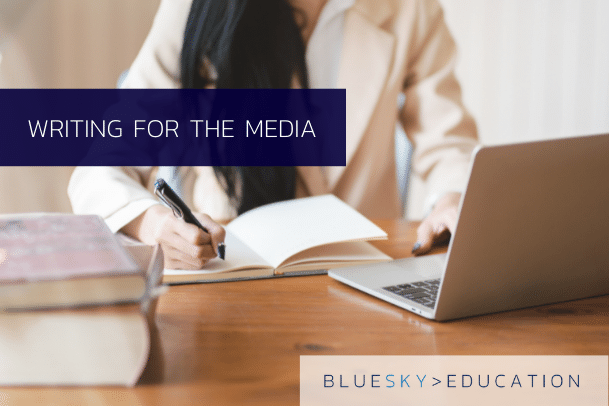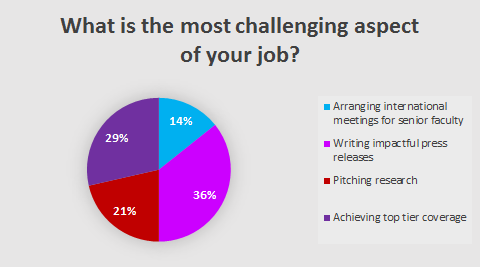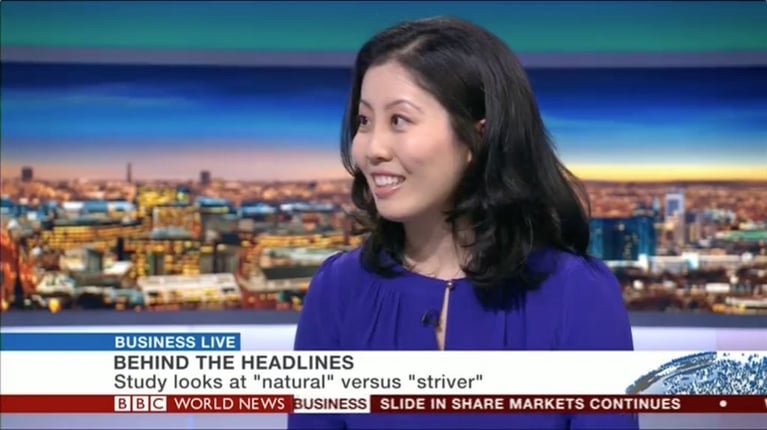
Return on Investment: How to Measure the Real Value of PR
Return on Investment. The crux of so many PR client meetings. Gone are the days of walking into a client’s office with a stack of newspapers that they’ve been featured in since the beginning of your contract; no longer can the value of PR be realistically measured by how much the table shakes when you drop that stack of coverage. So, how can it be measured?

Who are you pitching to?
When sending a pitch to a journalist, what’s the first thing you need to check before hitting send? Checking your information is accurate perhaps? Making sure it’s short, swift and to the point? Making sure you’ve spelled their name correctly?

Why academic writing doesn’t work for the media
The appetite for academic research in the media is huge. Studies and statistics lend credibility to comment pieces and provide great insight into current trends. But it’s not quite as straight forward as throwing dissertations at journalists!

Why you should always meet your deadlines, and what to do when you don’t
Meeting deadlines is vital. It is not rocket science to see why this is such an important rule in PR.

Why a business school’s faculty is the best comms tool they have
The business education market is becoming increasingly crowded every year – with over 16,000 business schools in the world currently according to AACSB International – so you have the tough task of convincing students, corporate partners and faculty that your school is the right one for them.

How PRs should use Twitter as a professional tool
Social media platform Twitter boasts over 330 million global users, and has quickly become the go to site for journalists, PRs and the general population, to view and share news. With around three quarters of journalists using Twitter every day and over 70% of them stating that Twitter is a valuable professional tool, it harnesses the potential to be a great platform for PRs to utilise, to the benefit of themselves and their clients.
What three films can teach us about PR
Now that I’ve entered the world of PR, I can see the lessons that some films can teach us about the varied world of public relations. I’ve selected three film quotes that stood out to me and the messages they convey about this industry. Be creative “Almost Famous” is the story of a young, up and coming journalist in the 1960s who is given the job of interviewing his favourite band. He ends up in a world of sex, drugs, and rock and roll, without his overprotective mother knowing, he ends up falling in love with one of the bands most infamous groupies. My favourite PR quote from the film is: “Is it hard to make us look cool?” Making your client appear interesting to the media is a major aspect of public relations, and sometimes it seems impossible to make them “look cool”. In the world of Business Education, sometimes clients want you distribute challenging research, or a story that might have already been told. This is why creativity is important, taking the time to come up with a new angle in order to provide the media with a fresh way of telling, or adding to, a story. If you can successfully execute this, you will build your clients' profiles and credibility around the world, essentially making them “look cool”. Don't over-complicate things “One Day” is about two university graduates who spend the night together after their graduation ceremony. Dexter and Em are shown each year on the same date to see where they are in their lives, sometimes they are together, sometimes they are not. The best PR quote from this film is: “I think we like to complicate things when really it’s quite simple”. To successful grab an editor’s attention you have to develop the knack of writing in a simple way, making the wording engaging and understandable. The same can be said when working with university research, to transfer it from academic language into a message that you can send to the media which is as simplistic as possible. This is the best way to reach a wider audience. Make the right decisions

Why relationship building is essential for PR success
Relationship building is key when it comes to gaining success in public relations – especially in the world of business schools.

Easy New Year’s Resolutions for PRs
Now is the time to make some professional resolutions which will make you a better, more productive PR person.

Cut out the complex words to get media attention
From the Daily Mirror to the Wall Street Journal, pretty much every widely-read newspaper uses clear language for their readers.

PRs, if you had one pearl of wisdom – what would it be?
Avoiding disaster, navigating networking, and pitching like a pro – what advice would our BlueSky team have for the world of the PR professional?

5 tips to make your pitch stand out from the crowd
Journalist’s jobs are becoming more and more time-pressed, with their inboxes increasingly flooded with PR’s pitches. Now more than ever, for a journalist to buy into a pitch, it needs to capture their attention. But how as a PR can you make your pitch stand out from the crowd ? Make sure it's newsworthy Journalists are inundated with pitches daily, so ones that are boring, uninteresting, and un-newsworthy are destined to fail before they’ve even been sent. ‘The 5 best paints to watch dry’, for example, will never get coverage no matter how amazing your pitch is, or how slow a news week it has been. It is a PR’s responsibility to evaluate whether or not their story is newsworthy before pitching it. Deciding this beforehand stops you from wasting both yours and the journalist’s time, and avoids disappointment when your efforts inevitably fail to deliver results. Have a creative, engaging headline The first part of a pitch that a journalist will read is the headline, and many journalists will decide whether or not they will bother to read on purely based on how interesting that headline is. This is why it is important you pay as much attention to crafting an effective email header as you do to your pitch, as this will encourage the journalist to read more. Make it relevant You could write the most amazing pitch in the world, but if it isn’t pitched to the right publication, it will never be read. For instance, a pitch about a world-changing bacon product that actually makes you lose weight (if only!!), will never be read if you’re pitching it to ‘The Vegetarian News’. Of course this is an extreme example, however it has its relevance. It is important that, as a PR, you research exactly which publications are interested in the news you wish to share and, more importantly, which journalists from these publications are writing about it. This does take time, but it is a worthwhile exercise. After all, it is far better to pitch to five relevant journalists than scatter your pitch to 50 journalists who are not. Make it short and snappy Journalists barely have time in their day to open all their e-mails, let alone read them thoroughly. So, what makes you think they will have time to read your pitch, which is as long as a thesis? You must make your pitch short, snappy and to the point, summarising the story and ensuring the journalist can fully understand its significance. Cut out all of the unnecessary information – a journalist will not want to read waffle. It is important to ensure that every single word in your pitch is carefully selected leaving the journalist wanting to know more. A pitch should be like a wine tasting, the journalist should have a small glass, and want to come back to you for the whole bottle. Do not oversell

The Politics of PR
Business and politics have intertwined for thousands of years, to the point where they are almost impossible to unpick.

Increasing your chances of securing quality coverage
Any PR and communications professional will agree that securing media interest and coverage for your faculty can been a time-consuming project. On many occasions, it can be tempting to just read the synopsis of the research they give you, draft a quick email and fire it off to a number of journalists. But this doesn’t always work.

Top PR challenges for business schools and universities
PR and communications teams within business schools and universities can face numerous challenges. However, there are a few hurdles that all PR teams across the board would resonate with.

How to become a PR champion
You have to believe in it yourself before you can convince other people of the power of PR and to become a PR champion.

How to be an effective media spokesperson
When you step into the role of media spokesperson, it is full of challenges and pitfalls that could prove costly. But rather than viewing the dangers, it should be seen as the land of opportunity that can take your organisation forward. It is the chance to enhance your school’s brand and reputation.

Why journalists won’t quote your client…
Sometimes, no matter how much effort you put in, things just don’t work out. You might think your client is the ideal person to feature in a journalist’s article about the advancements of online education or the gender pay gap, you’ve swiftly pitched them to the journalist listing their various attributes, and you might have even submitted a comment or secured a phone interview. But, when the article is published your client has not managed to make it into the text - so why don't journalists quote your client? It's frustrating? Yes. And it can happen for a myriad of reasons, many of which might be outside of your control – for example the journalist might not have had enough space within the word count to squeeze in your client’s comments. But there might be a little more to it. Are you doing all you can to give your client the best chance possible of being quoted? Being proactive and quick to jump on a news story is only part of the process. Keeping these four checkpoints in mind when pitching your clients to the media, whilst not guaranteeing a positive result every time, can help to reduce the number of occasions where your client is left disappointed.

Getting ahead of the news cycle
It’s hard to remember a time when Donald Trump was not dominating the daily news cycle, all he has to do is tweet – although it’s often controversial – and it goes viral.

How to use PR to improve student recruitment
It’s a given now that every business school wants a diverse MBA class and is presumably recruiting across the world. The fall back thing that everybody does is to advertise. The problem with advertising of course is that people are becoming more worldly and cynical about adverts. Therefore, by comparison, PR is very powerful because it can tell stories and engage people, and has that third party seal of approval – it is not just you saying something, it’s a journalist writing about it. What type of content successfully improves student recruitment? What really works? The voice of the student from the particular country you are targeting, who has gone to your school and talks about what the experience was like for them. An interview with the person who upped sticks from the country in question and came to your school, completed the qualification and is now doing really well and has set up an interesting business. Yet some schools still fall into the trap of using unbelievable case studies that only show the positive aspects - where everything is “brilliant”. And it comes across as an advert. What is much more effective is the ‘warts and all’ picture, because life simply isn’t perfect.

How to get buy-in from faculty
Without publicity and a well-known reputation, a business or institution may have a hard time growing and thriving in its respective industry. A steady stream of efficient marketing strategies can help build an audience. This is where public relations can help build, promote and manage brand reputation.

Best research in the media 2016
From how to improve online dating success – top tip: forget the anonymity feature – to how to navigate retirement, 2016 was a varied year in the world of press releases and pitches for our clients here at BlueSky Education. As another year ended, I looked back on the research I worked on during the past 12 months and highlighted some of my favourites.

How to develop an international PR strategy
You might be well-versed when it comes to PR in your local country; you know which publications to target with which story and have already built relationships with a number of local journalists, but when it comes to gaining coverage internationally, it might take a little something extra for you to grab their interest and secure that op-ed, comment, or interview.

How business schools can engage with companies
There are various stakeholders within a target company with whom it might be appropriate to discuss the topic of business education. Those in the C-suite, for example, are likely to take an interest in the training of their managers and executives. However, for the purpose of this post we are specifically looking at what is possibly the key group of stakeholders – HR.

A lesson in poetry with John Byrne
When Poets and Quants first landed, many just thought that it was another business school website that covered campus news, rankings and admissions for MBA hopefuls.
Cutting through the noise: Quirky PR for Business and Higher Education
Business Education is a mature market, and with so many programmes out there and relatively few publications writing about them, there is a constant competition between schools for worthwhile coverage. On the other side of the fence, journalists are under considerable pressure to deliver news from education institutions in a new and engaging way.
